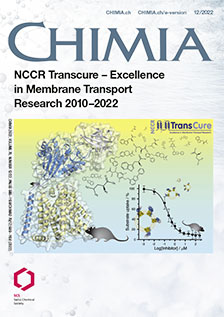The Structural Basis for Metal Ion Transport in the SLC11/NRAMP Family
DOI:
https://doi.org/10.2533/chimia.2022.1005PMID:
38069795Keywords:
DMT1, Secondary active transport, Transition metal ion selectivityAbstract
The SLC11/NRAMP proteins constitute a conserved family of metal ion transporters that are expressed in all kingdoms of life. In humans, the two paralogs DMT1 and NRMP1 play an important role in iron homeostasis and the defense against pathogens. SLC11 transporters have evolved an exquisite selectivity for transition metal ions, which facilitates their efficient transport from a large background of Ca2+ and Mg2+. This is accomplished by the evolution of a conserved binding site, which contains besides promiscuous hard ligands, a methionine acting as soft ligand that exclusively coordinates transition metals and thus contributes to the exclusion of alkaline earth metal ions. This site is altered in a branch of prokaryotic family members, which are capable of transporting Mg2+, where the removal of the coordinating methionine and the accompanying expansion of the binding pocket captures this small ion in a hydrated state. The disposition of titratable residues in H+-coupled transition metal ion transporters, that are absent in uncoupled Mg2+ transporters, sheds light on potential coupling mechanisms. In combination, the discussed work has revealed detailed insight into transition metal ion transport and provides a basis for the development of inhibitors of DMT1 as strategy against iron overload disorders.
Funding data
-
Schweizerischer Nationalfonds zur Förderung der Wissenschaftlichen Forschung
Grant numbers 51NF40-185544
Downloads
Published
Issue
Section
License
Copyright (c) 2022 Cristina Manatschal, Raimund Dutzler

This work is licensed under a Creative Commons Attribution 4.0 International License.







